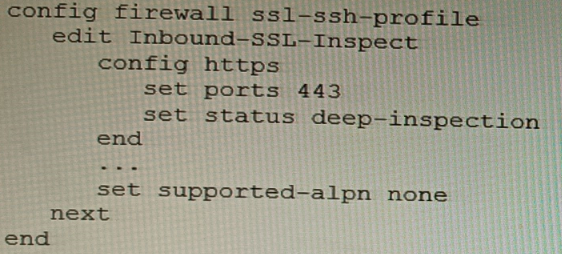Most Recent Fortinet NSE8_812 Exam Questions & Answers
Prepare for the Fortinet NSE 8 - Written Exam exam with our extensive collection of questions and answers. These practice Q&A are updated according to the latest syllabus, providing you with the tools needed to review and test your knowledge.
QA4Exam focus on the latest syllabus and exam objectives, our practice Q&A are designed to help you identify key topics and solidify your understanding. By focusing on the core curriculum, These Questions & Answers helps you cover all the essential topics, ensuring you're well-prepared for every section of the exam. Each question comes with a detailed explanation, offering valuable insights and helping you to learn from your mistakes. Whether you're looking to assess your progress or dive deeper into complex topics, our updated Q&A will provide the support you need to confidently approach the Fortinet NSE8_812 exam and achieve success.
The questions for NSE8_812 were last updated on Jan 20, 2025.
- Viewing page 1 out of 12 pages.
- Viewing questions 1-5 out of 60 questions
Refer to the exhibit, which shows the high availability configuration for the FortiAuthenticator (FAC1).

Based on this information, which statement is true about the next FortiAuthenticator (FAC2) member that will join an HA cluster with this FortiAuthenticator (FAC1)?
A customer wants to use the FortiAuthenticator REST API to retrieve an SSO group called SalesGroup. The following API call is being made with the 'curl' utility:

Which two statements correctly describe the expected behavior of the FortiAuthenticator REST API? (Choose two.)
To retrieve an SSO group called SalesGroup using the FortiAuthenticator REST API, the following issues need to be fixed in the API call:
The API version should be v2, not v1, as SSO groups are only supported in version 2 of the REST API.
The HTTP method should be GET, not POST, as GET is used to retrieve information from the server, while POST is used to create or update information on the server. Therefore, a correct API call would look like this: curl -X GET -H ''Authorization: Bearer <token>'' https://fac.example.com/api/v2/sso/groups/SalesGroup References: https://docs.fortinet.com/document/fortiauthenticator/6.4.1/rest-api-solution-guide/927310/introduction https://docs.fortinet.com/document/fortiauthenticator/6.4.1/rest-api-solution-guide/927311/sso-groups
A customer is planning on moving their secondary data center to a cloud-based laaS. They want to place all the Oracle-based systems Oracle Cloud, while the other systems will be on Microsoft Azure with ExpressRoute service to their main data center.
They have about 200 branches with two internet services as their only WAN connections. As a security consultant you are asked to design an architecture using Fortinet products with security, redundancy and performance as a priority.
Which two design options are true based on these requirements? (Choose two.)
a) Systems running on Azure will need to go through the main data center to access the services on Oracle Cloud. This is because the Oracle Cloud is not directly connected to the Azure Cloud. The traffic will need to go through the main data center in order to reach the Oracle Cloud.
c) Branch FortiGate devices must be configured as VPN clients for the branches' internal network to be able to access Oracle services without using public IPs. This is because the Oracle Cloud does not allow direct connections from the internet. The traffic will need to go through the FortiGate devices in order to reach the Oracle Cloud.
The other options are not correct.
b) Use FortiGate VM for IPSEC over ExpressRoute, as traffic is not encrypted by Azure. This is not necessary. Azure does encrypt traffic over ExpressRoute.
d) Two ExpressRoute services to the main data center are required to implement SD-WAN between a FortiGate VM in Azure and a FortiGate device at the data center edge. This is not necessary. A single ExpressRoute service can be used to implement SD-WAN between a FortiGate VM in Azure and a FortiGate device at the data center edge.
An HA topology is using the following configuration:

Based on this configuration, how long will it take for a failover to be detected by the secondary cluster member?
The HA heartbeat interval is 100ms, and the number of lost heartbeats before a failover is detected is 2. So, it will take 2 * 100ms = 200ms for a failover to be detected by the secondary cluster member.
FortiGate High Availability: https://docs.fortinet.com/document/fortigate/7.0.0/administration-guide/647723/link-monitoring-and-ha-failover-time
Refer to the CLI configuration of an SSL inspection profile from a FortiGate device configured to protect a web server:

Based on the information shown, what is the expected behavior when an HTTP/2 request comes in?
The supported-alpn parameter is set to http1.1 in the SSL inspection profile. This means that the FortiGate will only accept HTTP/1.1 traffic. Any HTTP/2 traffic will be rejected.
The following is the relevant documentation from Fortinet:
The supported-alpn parameter specifies the list of ALPN protocols that the FortiGate will accept. If the client requests a protocol that is not in this list, the FortiGate will reject the connection.
The default value for the supported-alpn parameter is all. This means that the FortiGate will accept any ALPN protocol that the client requests.
To reject all HTTP/2 traffic, set the supported-alpn parameter to http1.1.
Source: https://docs.fortinet.com/document/fortigate/7.0.0/new-features/710924/http-2-support-in-proxy-mode-ssl-inspection
Unlock All Questions for Fortinet NSE8_812 Exam
Full Exam Access, Actual Exam Questions, Validated Answers, Anytime Anywhere, No Download Limits, No Practice Limits
Get All 60 Questions & Answers